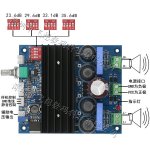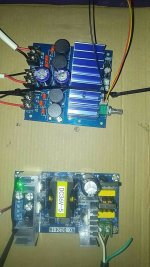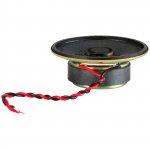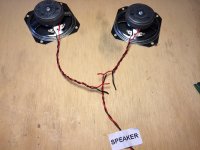Thanks for the advice, mr Pirate!
Would you please tell some more about your choice of output caps? I'll be using 8ohm speakers and I don't know how to match those caps.
Cheers
Per the TDA7498 datasheet, the output cap C20 and C26 should be 470nF for 8 ohm speakers (680nF for 6 ohm) and on this module, that is what they are. I have verified that C18, C22, C24, and C28 are 220nF per the datasheet, the output caps are all in line with the test circuit in the datasheet. The resistors in the output filter are 10 ohm on the board and 8 ohm on the test circuit. 22uH inductors, same as test circuit. All in all, very close to the recommended output filter. With good input caps, very low esr rail caps, this unit sounds very nice.
Hey pirate
What are the other two small boards on the right for? Not wired up yet. I am digging some mellow jazz with my stock blue sanwu board, wow stock sound is great. No listening fatigue like the other board I've tried. Mine is the board with 4x330uf 35V caps on both sides of heatsink i suppose they are input caps? Doesn't add up to what u say the test board calls for? You think it's worth upgrading to 470 d 4?
What are the other two small boards on the right for? Not wired up yet. I am digging some mellow jazz with my stock blue sanwu board, wow stock sound is great. No listening fatigue like the other board I've tried. Mine is the board with 4x330uf 35V caps on both sides of heatsink i suppose they are input caps? Doesn't add up to what u say the test board calls for? You think it's worth upgrading to 470 d 4?
I have a couple questions about improving one of these boards(XH-M512 version):
The version of the board I have matches the datasheet output filter almost exactly for 6 ohm (which my speakers are) except for 33uH inductors instead of 22uH. How important is the 22 vs 33 uH? They're shielded SMT inductors with virtually no space next to the pads so it would quite hard to desolder and replace unless this plays a big factor in sound quality.
Secondly all of the yellow film caps do match for the correct values on output filter and input caps. Would replacing these with brand name film caps or increasing the input capacitance make any improvements?
The version of the board I have matches the datasheet output filter almost exactly for 6 ohm (which my speakers are) except for 33uH inductors instead of 22uH. How important is the 22 vs 33 uH? They're shielded SMT inductors with virtually no space next to the pads so it would quite hard to desolder and replace unless this plays a big factor in sound quality.
Secondly all of the yellow film caps do match for the correct values on output filter and input caps. Would replacing these with brand name film caps or increasing the input capacitance make any improvements?
I've had my Sanwu 7498 for around a month and it suddenly failed with no output. Power supply voltages looked good (as far as I could probe without taking off the heatsink) and the solder joints seemed solid. I noticed that the heatsink failed to warm up like it used to, even though the amp had been powered up for a while.
Removing the heatsink was extremely difficult and in the process the chip was pulled up and I broke a couple of the traces on the board. Fixing those to the best of my ability and resoldering the chip didn't work, despite seeing proper voltages at the inputs to the chip.
Maybe 24V was too much for the 7498 and this tiny heatsink - the heatsink was quite hot when the amp was idling without anything playing (when it worked). Anyways, my amp is now toast.
Removing the heatsink was extremely difficult and in the process the chip was pulled up and I broke a couple of the traces on the board. Fixing those to the best of my ability and resoldering the chip didn't work, despite seeing proper voltages at the inputs to the chip.
Maybe 24V was too much for the 7498 and this tiny heatsink - the heatsink was quite hot when the amp was idling without anything playing (when it worked). Anyways, my amp is now toast.
Last edited:
Removing the heatsink was extremely difficult and in the process the chip was pulled up and I broke a couple of the traces on the board. Fixing those to the best of my ability and resoldering the chip didn't work, despite seeing proper voltages at the inputs to the chip.
Well, I wouldn't exactly expect it to work after that ordeal because it was defect in the first place afterall.
Maybe 24V was too much for the 7498 and this tiny heatsink - the heatsink was quite hot when the amp was idling without anything playing (when it worked). Anyways, my amp is now toast.
The amp got a thermal shutdown/protection, that should not be the cause. The TDA7498 can be used up to 39V (not recommended though unless you are using high impedance speakers) and got a over-voltage protection at 42V, so that's not the problem either. What kills most of these amps is if you cross-connect the output/speaker wires or short them to + or -/gnd.
If your amp gets too hot and the heatsink is glued on, in most cases it's better to leave that be and instead of changing the heatsink, add a small fan.
I treated this as PCB rework practice, and didn't really have high expectations... but it was worth a try. The speaker cables were attached securely and shouldn't have touched anything without me knowing. I checked the speakers (16 ohm Pioneer SX-7) and those aren't shorted.
The chip is dead though, so that's that. Sometimes, these things just happen and you have no idea why. I've been itching to do some design work again and this might push me to design a new amp this winter break. Still have some plans for a full-digital Class D sitting in a notebook somewhere
The chip is dead though, so that's that. Sometimes, these things just happen and you have no idea why. I've been itching to do some design work again and this might push me to design a new amp this winter break. Still have some plans for a full-digital Class D sitting in a notebook somewhere
Just to inform others...
The tda7498 amp(with the single 35v cap design) not only kills FM reception in my house but in the vicinity also. When this amp is switched on, android phones in the other room no longer catch FM signal. In the neighbours house, their FM reception gives lot of static noise.
: evil :
The tda7498 amp(with the single 35v cap design) not only kills FM reception in my house but in the vicinity also. When this amp is switched on, android phones in the other room no longer catch FM signal. In the neighbours house, their FM reception gives lot of static noise.
: evil :
Just to inform others...
The tda7498 amp(with the single 35v cap design) not only kills FM reception in my house but in the vicinity also. When this amp is switched on, android phones in the other room no longer catch FM signal. In the neighbours house, their FM reception gives lot of static noise.
: evil :
An externally hosted image should be here but it was not working when we last tested it.
No problems here. I have this configuration whithout case. No interference, no static noise.
hey guys, i just ordered this board:
US TDA7498 BTL 100W+100W High-power Digital Amplifier Board AMP With Radiator | eBay
and this power supply:
AC-DC Inverter 110V 120V 100-265V to 36V 5A Adapter Switching Power Supply SMPS | eBay
Any reason these will not work together? anything I should consider when connecting the 2? dont want to fry either board I figured the power supply i bought was very similar to what you would see inside one of the big brick adapters so it should work just fine.
I figured the power supply i bought was very similar to what you would see inside one of the big brick adapters so it should work just fine.
US TDA7498 BTL 100W+100W High-power Digital Amplifier Board AMP With Radiator | eBay
and this power supply:
AC-DC Inverter 110V 120V 100-265V to 36V 5A Adapter Switching Power Supply SMPS | eBay
Any reason these will not work together? anything I should consider when connecting the 2? dont want to fry either board
Last edited:
hey guys, i just ordered this board:
US TDA7498 BTL 100W+100W High-power Digital Amplifier Board AMP With Radiator | eBay
and this power supply:
AC-DC Inverter 110V 120V 100-265V to 36V 5A Adapter Switching Power Supply SMPS | eBay
Any reason these will not work together? anything I should consider when connecting the 2? dont want to fry either boardI figured the power supply i bought was very similar to what you would see inside one of the big brick adapters so it should work just fine.
Well, why didn't you ask before buying it? It's fine as long as your load stays above 6 Ohm. You can't use the full power of the amp because the power supply is on the limit before the amp is at the max.
A 30 or 24V power supply would have been the better choice but it's fine with 8 Ohm speakers.
That power supply will be OK.
connections TDA7498e board
Hi all and Yatsushiro, I am new and the past weeks I read all your messages and learned a lot about this boards and the rest. Thanks for that interesting stuff! I am very happy with my RPI 2 with Mamboberry dac and want to connect it to an class D amplifier. I bought your favourite tda7498e and got it yesterday.
Can you help me with the connections? My Chinese is not very best

The only I understand is the speaker and power connection. thanks in advance!!
I have 3 7498/7498E boards, this is my favourite (driven by RPi running PcP, Allo Piano DAC, into Q Acoustics 2050i speakers). Adjustable gain, can be switched into mute/standby modes, low current 12v out for LED, smooth volume pot, no pops - a very quiet amp.
TDA7498E 160WX2 digital stereo amplifier board PBTL 220W mono channel 24v-36v | eBay
Hi all and Yatsushiro, I am new and the past weeks I read all your messages and learned a lot about this boards and the rest. Thanks for that interesting stuff! I am very happy with my RPI 2 with Mamboberry dac and want to connect it to an class D amplifier. I bought your favourite tda7498e and got it yesterday.
Can you help me with the connections? My Chinese is not very best
The only I understand is the speaker and power connection. thanks in advance!!
Attachments
hey guys, i just ordered this board:
US TDA7498 BTL 100W+100W High-power Digital Amplifier Board AMP With Radiator | eBay
and this power supply:
AC-DC Inverter 110V 120V 100-265V to 36V 5A Adapter Switching Power Supply SMPS | eBay
Any reason these will not work together? anything I should consider when connecting the 2? dont want to fry either boardI figured the power supply i bought was very similar to what you would see inside one of the big brick adapters so it should work just fine.
Got all the parts in and put them together
Simply zip tied to a piece of cardboard for prototyping
Next purchase will be a wooden amp enclosure, all the required connectors and safety bits as wel
Sounds awesome on my Acoustic Research dual 8 inch speakers though
Attachments
Go to any hardware store, buy rolls of red and black hookup wire, twist up as much as you need. You can use an electric drill to do the work if you want to get a nice uniform twist.
Thanks alot DrewT. Will these work or too thick?
Audiopipe 14 GA Black and Red power Ground Speaker wire 25FT Hook Up Cable | eBay
- Status
- Not open for further replies.
- Home
- Amplifiers
- Class D
- Ebay cheap TDA7498 boards




